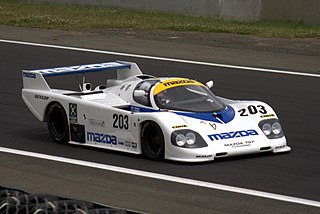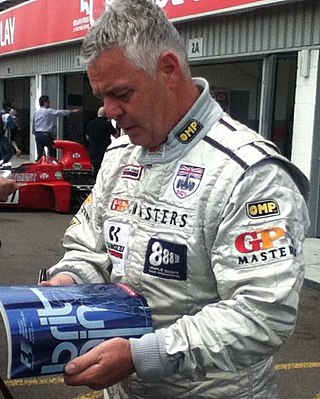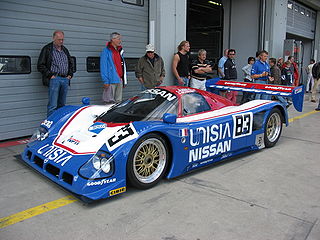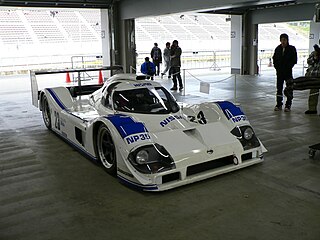The International Motor Sports Association (IMSA) is a North American sports car racing sanctioning body based in Daytona Beach, Florida under the jurisdiction of the ACCUS arm of the FIA. It was started by John Bishop, a former executive director of SCCA, and his wife Peggy in 1969 with help from Bill France Sr. of NASCAR. Beginning in 2014, IMSA is the sanctioning body of the WeatherTech SportsCar Championship, the premier series resulting from the merger of Grand-Am Road Racing and the American Le Mans Series. IMSA is owned by NASCAR, as a division of the company.

The Mazda 787 and its derivative 787B are Group C sports prototype racing cars that were developed by Japanese automobile manufacturer Mazda for use in the World Sportscar Championship, All Japan Sports Prototype Championship, and the 24 Hours of Le Mans from 1990 to 1991. Designed to combine a mixture of the Fédération Internationale du Sport Automobile (FISA) Group C regulations with the International Motor Sports Association (IMSA) GTP regulations, the 787s were the last Wankel rotary-powered racing cars to compete in the World and Japanese championships, using Mazda's R26B engine.

The Mazda 757 is a prototype racing car built by Mazdaspeed for the 24 Hours of Le Mans running under the IMSA-spec GTP class. It replaced the previous lineage of Group C2 class cars which ended with the 737C and was the first chassis built entirely by Mazdaspeed and designed by Nigel Stroud. The 747 designation was skipped to avoid confusion with the second generation Mazda RX-7, which was developed under the codename P747. The 757 used a new 3-rotor 13G Wankel engine.

A Le Mans Prototype (LMP) is a type of sports prototype race car used in various races and championships, including the 24 Hours of Le Mans, FIA World Endurance Championship, IMSA SportsCar Championship, European Le Mans Series and Asian Le Mans Series. Le Mans Prototypes were created by the Automobile Club de l'Ouest (ACO). The technical requirements for an LMP include bodywork covering all mechanical elements of the car. As of 2023, there are two classes within Le Mans Prototypes, designated LMP2 and LMP3.

The Porsche 962 is a sports prototype racing car designed and built by Porsche. Created to replace the Porsche 956, 962 was introduced at the end of 1984 and replaced the 956 in the IMSA's GTP class in 1985 due to regulation changes obsoleting the 956. It was also introduced in the World Sportscar Championship's Group C category in 1984. Over its decade-long career, the car in its Group C form won the 24 Hours of Le Mans twice, with a derivative of the car, the Dauer 962 Le Mans, winning a further title in 1994. In total, the 962 scored nineteen total constructor's championships across various series. The 962's successor was the Porsche WSC-95, introduced for the 1996 24 Hours of Le Mans, but did not receive factory backing or support.

The Toyota TS010 was a Group C racing car built by Toyota for the Sportscar World Championship, All Japan Sports Prototype Championship, and the 24 Hours of Le Mans.
Joest Racing is a sports car racing team that was established in 1978 by former Porsche works racer Reinhold Joest. Their headquarters are in Wald-Michelbach, Germany.

The Jaguar XJR-14 is a sports-prototype racing car introduced for the 1991 World Sportscar Championship season. It was designed by Ross Brawn and John Piper, and was built and run by Tom Walkinshaw Racing (TWR), on behalf of Jaguar Cars.

The 1992 Sportscar World Championship season was the 40th and final season of FIA World Sportscar Championship motor racing. It featured the 1992 FIA Sportscar World Championship, which was contested over a six race series which ran from 26 April to 18 October 1992. The championship was open to Group C Sportscars.

The Mazda MXR-01 is a Group C sports prototype that was used by Mazda's factory team Mazdaspeed in the 1992 World Sportscar Championship season. It would be the final Mazda entry in sports car racing since the inception of its Le Mans project in 1983. It was based on the Jaguar XJR-14.

Spice Engineering was a British racing team founded by driver Gordon Spice with Raymond Bellm in the early 1980s, later becoming a successful sports car constructor in 1986. They competed in the World Sportscar Championship in Europe as well as the IMSA GT Championship in North America, at times partnering with major manufacturers such as General Motors and Honda as well as race engine manufacturer Comptech.

The Lola T92/10 was a Group C sports car developed by Lola Cars as a customer chassis for the 1992 World Sportscar Championship season. It would be the final sports car built by Lola until their return in 1998.

IMSA GT was a sports car racing series organized by International Motor Sports Association. Races took place primarily in the United States and occasionally in Canada.

The Nissan R90C was a platform used for Group C racing cars built in 1990 by Nissan Motors for competition in World Sportscar Championship (WSC) based in Europe and the All Japan Sports Prototype Championship (JSPC). The cars based on the basic R90C platform would compete until 1993 before Nissan chose to withdraw from sports car racing, not returning until 1997. It won three JSPC championships and several significant endurance races during its career.

The Nissan P35 was a planned Group C car built by Nissan Motors for competition in the World Sportscar Championship. Developed by Nissan Performance Technology Inc. (NPTI), which had formerly raced under the name Electramotive in the United States, the cars were intended to be completed by the middle of 1992, with competition starting in 1993. However economic troubles for Nissan led to the cancellation of the project soon after testing of the first cars had begun, meaning that the P35s never raced.

The Nissan NPT-90 was a racing car developed in 1990 for Nissan Motors by Nissan Performance Technology Incorporated (NPTI), formerly known as Electramotive Engineering. It was a replacement for the highly successful GTP ZX-Turbo that had won the IMSA GT Championship in 1989. The NPT-90 would go on to win the championship in 1990 and 1991 before being retired by Nissan at the end of the 1992 season.
The Lola T616 is a sports prototype built by Lola Cars to the Group C2 and IMSA GTP regulations. It was built with the intention to compete in the IMSA GT Championship and the World Sportscar Championship, and became the second Mazda-powered prototype to score a class win at the 24 Hours of Le Mans after the 717C triumphed in the same C2 class at the 1983 24 Hours of Le Mans.

The Eagle MkIII is a sports prototype racing car built by All American Racers in 1991 to IMSA GTP specifications. Powered by a turbocharged Toyota inline-4 engine, the car was campaigned in the IMSA Camel GT series by Dan Gurney's Toyota-sponsored AAR team from 1991 through to the end of 1993. The Eagle MkIII won 21 out of the 27 races in which it was entered and is considered one of the most successful and technologically advanced designs of the IMSA GTP era — "a car that proved so overwhelmingly dominant that the class for which it was created has now been assigned to history", according to Racer magazine.
The Mazda GTP is an IMSA GTP race car that was built by Pierre Honegger in 1981. Based on a Mazda RX-7, the car initially competed in the GTX category as the Mazda RX-7 GTP, before it was rebuilt for the IMSA GTP category in 1983. Throughout its career, the car used a Mazda 13B Wankel rotary engine, similar to that used in the production RX-7s. Although the rotary-engined sports prototypes generally had a reputation of being very reliable, the Mazda GTP frequently failed to finish races, and was never able to better the eighth place achieved at the 1983 24 Hours of Daytona. In 1986, one car was purchased by Erie Scientific Racing, and rebuilt to become the Badger BB. This car was no more successful or reliable than its predecessor, and was last used in 1989, by which point it was owned by Jack Engelhardt. The other car, meanwhile, was rebuilt by Honegger into the Denali Speedcar, which was used with moderate success in 1986 and 1987.
Crawford Composites is an American manufacturer of carbon fiber and composite parts company based in Denver, North Carolina. Crawford designs and manufacture structural and non-structural composite components in industries such as aerospace, aviation, motor sports, health care, defense and structural construction.
Fuller, Michael J. and J.A. Martin, Inside IMSA’s Legendary GTP Cars: The Prototype Experience. Minneapolis: Motor Books International, 2008. Pages 232-245.















